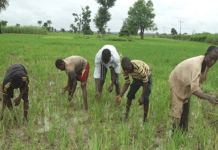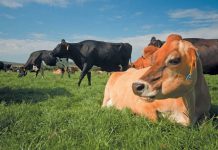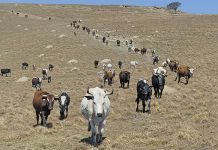Cultivation Methods
Water is required as the humidity levels are important. Temperatures need to be controlled carefully but will depend on the variety of mushroom being grown. Cultivation techniques will need to be adapted to local conditions. The crop takes about 12 weeks from start to finish.
Once the substrate and the spawn have been mixed they can be packed into plastic bags. Another common approach in Zimbabwe is to use trays. These are usually made by the farmer and can vary in size from 0.5m2 to 0.72m2. Metal mesh trays with plastic linings have also been used.
Slits are made in the bags to allow the mushrooms to grow. This approach requires very little space and by growing in bags contamination can be can reduced as the plastic will protect the substrate.
It is important to prevent cavities forming within these bags. Any gaps that are left after the filling process can be eliminated by dropping the bag from a low height onto a firm surface a few times. The bags are then hung from the rafters of the growing shed and the colonisation of the substrate by the mycelium begins. This takes about 10 days. Deformed mushrooms appearing under the plastic indicate that the substrate was not compacted enough and the mushrooms are growing in the cavities.
There should be air circulating between the sacks so that the temperature can be regulated. There should also be sufficient humidity to prevent the mushrooms from drying out.
If the substrate in the plastic bags is green or pink in any part and only partly showing signs of white mycelium growth then the ambient temperature may be too high. This may result in competitor moulds growing in place of the desired mushroom crop. If the mycelium has not grown to any extent but there are no signs of growth by other moulds then the temperature may be too low.
If the mycelium has not grown in the bottom of the bag then this indicates that the substrate is too wet. This can happen if the bag has not been drained properly after the fermentation stage so that water remains trapped at the bottom.
If the mushrooms are wrinkled and brown at the edges then it has been too dry during growing and more moisture should have been provided during the growing stage. They need to be sprayed with water on a regular basis.
Equipment options
For small scale production there are limited equipment requirements. For larger operations a steam unit can be used for pasteurising the substrate. These can be made from modified 200 litre drums.
Regulating the temperature is the other main concern – heating and cooling the mushroom house can be controlled with additional equipment. For example; an electric fire could be used to maintain an even temperature if electricity is available; cooling could be assisted by using a table fan blowing over a container of water. Humidity within the growing house can be increased by watering the floor.
Pests and Diseases
There are a whole range of pests and diseases that can attack mushrooms. The longer mushrooms are grown in one location the greater the chance of infection from pests and disease. Therefore it is important to sterilise the growing room and the preparation areas on a regular basis. Even with care there will be times when an infection occurs, so it is useful to be able in identifying the particular problem so that appropriate action can be taken. Record keeping is important to identify where problems arise. Information required includes dates of stages of compost preparation, nitrogen analysis, temperatures, moisture, pasteurisation times, opening and closing times of ventilation etc.
Some of the most likely problems are:
- Thread like worms or nematodes can infest substrates and eat the mycelium. They can appear in substrates that have not been pasteurised properly.
- Mushroom flies. The most common is the Sciarid fly. Again pasteurisation kills off the fly’s larvae but the flies can enter the growing room if there are holes in the screens. Cleaning between crops is important and sterilising equipment helps to prevent contamination.
- Mites can survive pasteurisation if it is not done for long enough.
- Bacterial blotch is the most common of diseases. It will show up as pale yellow spots on the cap and these will darken and the cap will become slimy. Over-humid conditions encourage bacterial blotch.
- Fungal Dry Bubble or Verticillium is the most common fungal threat in Zimbabwe. This initially shows up as brown spots on the cap and later on the mushrooms will become deformed. Agricura’s fungicide can be used to combat the infection.
- Competitor moulds will show up as unusual colours within the substrate such as green, brown and white moulds which indicate that the growing conditions are more suitable for these moulds than for the commercial mushrooms. There may be too much ammonia present or the substrate may be too wet and anaerobic conditions exist. Directly sprinkling calcitic limestone powder onto the mould will stop further growth and in more extreme cases broad spectrum fungicides can be used.
- False Truffle is resistant to pasteurisation and if these large fruitbodies appear then the substrate should be removed and the equipment sterilised with methyl bromide.
- Virus called Die Back Disease or La France Disease or Mummy Disease can occasionally be a severe problem destroying the whole crop. An infection shows up as absent or disappearing mycelium, deformed fruitbodies, and fruit discolouration that may appear greyish or brownish. All the equipment should be sterilised
Harvesting
Generally mushrooms are harvested by hand using knives to cut the ones that are ready. Pickers should be trained to recognise the appropriate stage for harvesting and be consistent in when the mushrooms are cropped. Handling should be kept to a minimum to reduce the risk of damaging the crop.
The total amount harvested from a stack can be 3 to 4kg. Once the harvest is complete the substrate is depleted and can not support any further crops. It is usually then used as a fertiliser for other crops.
Processing and marketing
Many mushrooms are sold fresh to retail outlets. Marketing of fresh mushrooms presents particular problems as they should be consumed within three or four days of harvesting to avoid spoilage. Often they are harvested in the day and sold in wholesale markets during the early hours of the following morning, or delivered directly to supermarkets and caterers.
Mushrooms are also suitable for drying, enabling them to be stored for long periods without deteriorating. This can be done using solar drying.
In larger set-ups cold rooms can be used to store the mushrooms before they are sent to market. The optimum temperature for storage is between 5 and 8°C.
Alternatively, they can be frozen and placed in airtight containers but unprocessed mushrooms take up a lot of room and this can be costly way of preserving them.
It is important to identify your market first, before investing in production. Growers should make sure that there will be a demand for the mushrooms once they have been produced.





